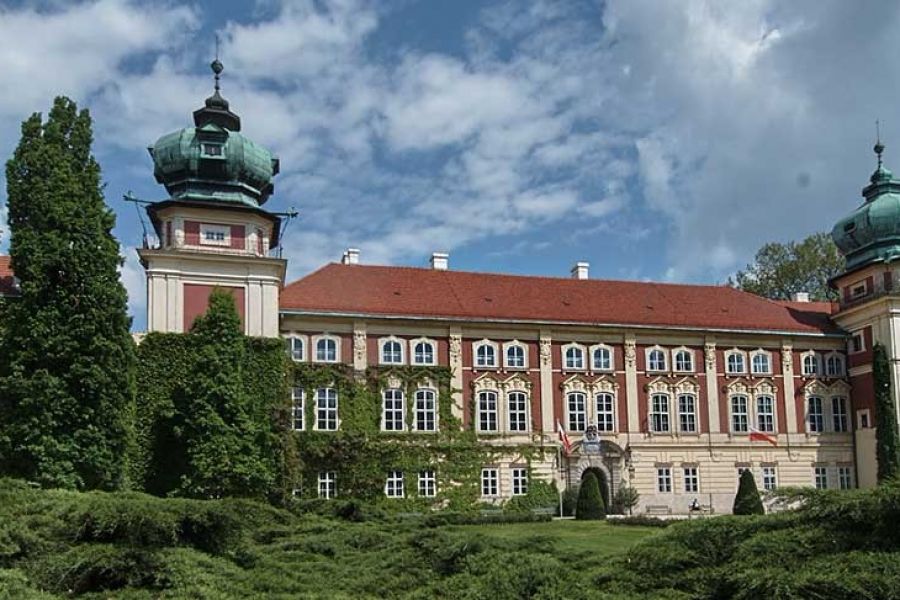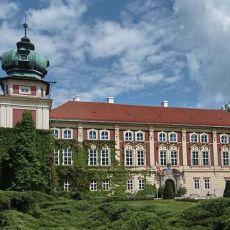Museum-Castle in Łańcut
37-100 Łańcut
tel.: 17 225 20 08
tel.: 17 225 20 09
tel.:17 225 20 10
fax.: 17 225 20 12
e-mail: muzeum@zamek-lancut.pl
Description
It is famous for its excellent residential interiors and an extremely interesting collection of horse-drawn vehicles. The palace complex is surrounded by an old, picturesque park in the English style, in which there are numerous pavilions and farm buildings, strictly once associated with the everyday life of the Łańcut residence.
The castle in Łańcut was erected on the orders of Stanisław Lubomirski in the years 1629-1642. It was a modern residence of the "palazzo in fortezza" type, consisting of a residential building with towers in the corners, surrounded by bastion fortifications. During its construction, among others, Maciej Trapola, Krzysztof Mieroszewski, Tylman z Gameren and Giovanni Battista Falconi were employed.
In the second half In the 18th century, the then owner of Łańcut Izabella from Czartoryski Lubomirska transformed the fortress into a palace and park complex. In Łańcut, many outstanding artists worked at the time, including Szymon Bogumił Zug, Jan Christian Kamsetzer, Christian Piotr Aigner, Fryderyk Bauman and Vincenzo Brenna.
The most important changes were introduced in the arrangement and equipment of the castle, adapting them to the needs and subordinating the currently prevailing fashion. The palace was filled with excellent works of art. In the seventies of the 18th century, the park surrounding the Castle began to be shaped. After neutralizing the floodplains, located along the covered road that runs around the moat, lindens were planted, which formed a walking alley.
At the end of the 18th century, Łańcut was one of the most magnificent residences in Poland. The musical and theatrical life flourished here, there were many great guests. In 1816, after the death of Princess Lubomirska, the whole estate became the property of her grandson Alfred I Potocki, who in 1830 created the ordinance in Łańcut. His son Alfred II Józef was closely associated with the Habsburg court. He was rare in Łańcut, so the castle and the park with him fell into neglect.
After the death of Alfred II, Łańcut passed into the hands of Roman Potocki, who together with his wife Elżbieta from Radziwiłł brought him back to his former glory. In the years 1889-1911 in the Castle a general renovation was carried out, combined with reconstruction. The work was led by Armand Beauque - French architect and Albert Pio - an Italian cartoonist. Reconstruction covered all floors. Founded, among others water supply and sewage system and the entire Castle electrified. At that time, most of the interiors that existed up to the present day were created. The elevations were transformed in the style of French neo-Baroque
Works in the park began in 1890 and were carried out for fourteen years. It was then enlarged twice and surrounded by a fence. In the immediate vicinity of the Castle, along the eastern elevation, the Italian Garden was established. From the southern part of the Orangery, Rose Garden was arranged.
After this thorough reconstruction and modernization, the Łańcut palace and park complex has become one of the most luxurious residences in continental Europe. The archdukes Rudolf and Franciszek Ferdynand often came here. There were many representatives of outstanding aristocratic families and well-known diplomats. At the beginning of the 20th century, the Łańcut ordination occupied the fifth place in Poland in terms of area.
Alfred III Potocki was the next ordinate from 1915. At that time, in the 1920s, a modernization of the central heating system was carried out in the Castle, and the Łaźnia was installed in the underground rooms.
The castle was visited by representatives of royal families, Polish and foreign aristocracy and politicians. Taken here, among others Romanian king Ferdinand with his wife and George the Prince of Kent with his wife and friends. In 1944, Potocki had to leave Łańcut. He settled in exile in Switzerland, where he died in 1958.
Museum-Castle in Łańcut
Visitors of the Castle Museum in Łańcut can admire, among others numerous works of art from the old Łańcut collections and post-war purchases and deposits from other museums. The oldest exhibits are part of the collection created by the duchess Lubomirska and found themselves in Łańcut in the second half of XVIII century
From February 2017 tourists can visit the previously closed second floor of the Castle, in which there are rooms with "home" character. All thanks to the renovation, which was possible, among others thanks to the support from Norwegian funds. The restoration work took place in all rooms on the second floor and in the first one - a ballroom, a gallery of sculptures, a parade staircase, a column room, a veranda room, a study in the south-east tower. and a Chinese apartment. They covered 84 rooms and concerned the entire interior from the ceilings, through the walls, lined with precious fabrics and paneling, window and door carpentry, wooden floors, often decorated with various types of wood. The restaurant has over 140 antique furniture and 65 lamps and chandeliers. Replacement of the electrical installation was installed while Count Potocki was still there. During the work interesting discoveries were made. Under the wallpaper from the turn of the 19th and 20th centuries, for example, the eighteenth-century paintings of Vincenz Brenna were found. During the renovation of the ceiling, seventeenth-century polychrome beams were discovered.
In addition, the guests of the palace and park complex can also admire the impressive buildings of the castle, neo-Baroque Stables, as well as the Coach House - a modernist facility with classic elements. They were erected at the turn of the 19th and 20th centuries according to the design of the French architect Amanda Bauque and were surrounded by a specially established "conceivable park". A stable, scrubbed and saddler device was ordered at the Vienna company R.Ph.Waagner.
Passionates of Orthodox art can view the collection of church art. Its creation was dictated by the need to protect priceless cultural goods, threatened by the displacement of the Ukrainian population from the area of south-eastern Poland in 1945 and 1947. A decade-long period of conscious destruction of religious artefacts led to the destruction of about 330 churches from 650 objects, existing in this part of the historical Przemyśl diocese, which after the Second World War was within the borders of the Polish state. The Łańcut collection is currently the largest collection of Ukrainian sacred art in Poland. The collections are surrounded by permanent conservation care, enriched by shopping of exhibits and made available to visitors.
An important part of the palace and park complex is Storczykarnia, consisting of: a display section, facilities divided into three climate zones and a summer cafe. The exhibition greenhouse has many types and species of orchids. The most spectacular plants that are in the flowering period find themselves there. For the remainder of the year, the flowers are grown in one of the three back-garden greenhouses, under the conditions of the climatic zone of origin. In Storczykarnia, both modern man-made crosses, botanical orchids - appropriate for the natural environment, shaped without human intervention, as well as historical species and varieties of orchids from the pre-war Potocki collection and those which were mentioned in the famous study entitled "Reichenbachia" from the 19th century, kept in the collection of the Castle Library in Łańcut.
Guests interested in the history of Łańcut and the region can go to the Department of History of the City and Region, created in 1979. Its creation was connected with the takeover of the synagogue building together with ethnographic collections and initiated the process of creating new exhibitions, initially operating under the name of the Regional Department. The collections from the area of the former Łańcut poviat were enriched with subsequent batch of exhibits, eventually forming three permanent exhibitions - bourgeois, regimental and ethnographic.
In 1984, at the initiative of the former Wache. Konstanty Bieniasz (1908-1995) - decorated with, among others With the Cross of Valor and the Knight's Cross of the Order of Polonia Restituta - the exposition of the 10th Rifle Regiment was established. The collection of memorabilia, after the soldier from Łańcut originated initially at the temporary exhibition, became the beginning of the permanent exhibition. Further acquisition of exhibits from the collections of former soldiers of the Regiment made it possible to create a collection that would provide an overview of the individual history of the Dziesiątaki, as well as a full view of the history of the Łańcut unit. The museum collection includes items from the times of World War II, but also from the interwar period - when Lancut was a garrison town of non-motorized formation. The collection consists of documents, photographs, uniforms, medals and decorations.
In 1996, existing collections were enriched with items directly related to the city's history. Exhibits being a source of knowledge about the material culture and customs of the society from the turn of the 19th and 20th centuries, allowed to recreate the interiors of a bourgeois house, as well as a room equipped with furniture from a former hairdresser's. The collections of techniques and other objects of everyday use, accompanying furniture, show the standard of living of contemporary society. However, the essence of knowing the history of the city is primarily a large collection of documents and iconographic materials. This exhibit includes guild privileges from the years 1564-1728, two 17th century village mayors, a copier of city privileges written down in the 18th century, old city postcards and photographs, as well as a number of private documents with seals from the Łańcut institutions.
The palace and park complex also includes the Castle Library - an aristocratic library, almost entirely preserved. The building was built at the end of the 18th century, at the request of the then owner of Łańcut Izabella from Czartoryski Lubomirska. The double-storey library pavilion was designed by Piotr Aigner. The present appearance of the library is due to the two architects Armand Bauque and Albert Pio, who rebuilt it in the years 1899-1903. They created a high-class room in a style reminiscent of the late-Victorian. Since 1998, the Castle Library collections have been included in the National Library Resources. Apart from the Castle Library, the Museum Library operates in the Łańcut Castle Museum in 1958. Literature in the field of history of art and culture, museology, conservation and protection of monuments is gathered there. The book collection is available in the reading room.
The castle in Łańcut together with the park surrounding it, was entered in 2005 into the prestigious list of Monuments of History. The origins of the Łańcut park date back to the 18th and 19th centuries when Stanisław Lubomirski, the Grand Crown Marshal and his wife Izabela from Czartoryski became the owners of the town. The next changes of the compositional arrangement took place at the end of the 19th century, in the times of Roman and Elżbieta Potocki, who rebuilt the Castle and took care of its proper surroundings. The works were attended by eminent specialists, often from abroad. At present, all works in the park are aimed at the most faithful reproduction of the composition arrangement and the species composition of plants from the early twentieth century.
Location
, 37-100 Łańcut








Comments
comments powered by Disqus